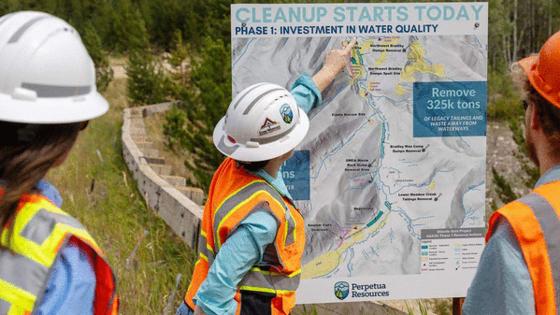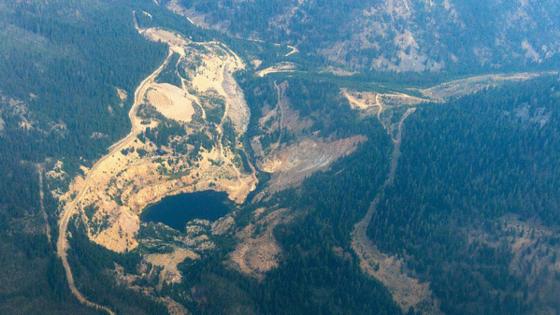Proponents tout Idaho gold-antimony mine as lawsuits threaten its prospects
Published in Science & Technology News
BOISE, Idaho — In the face of mounting legal challenges, the corporate backers of a gold and antimony mine in Central Idaho hosted state and federal dignitaries Friday at the remote site to celebrate recent approvals that have advanced the multibillion-dollar venture — which is at least another three years from operations.
The occasion, labeled a “ribbon cutting” by Perpetua Resources, the mining company behind the large-scale project, was more than eight years in the making. The U.S. Forest Service took that length of time before giving its blessing for the open-pit mine in the Payette National Forest mountains east of McCall — a point of frustration about such permits for Idaho’s federal lawmakers, who have all fully endorsed the project.
Perpetua earned federal approval in January to reopen the abandoned site near the community of Yellow Pine, which has been mined off and on dating to the late 19th century. The publicly-traded Canadian gold mining firm, now with its headquarters in Boise, spent handsomely to push what it called the Stibnite Gold Project through the demanding environmental review process.
“After eight years of extensive permitting review and over $400 million invested, it is finally time for the Stibnite Gold Project to deliver for America,” Jon Cherry, Perpetua’s president and CEO, said in a news release. “A united vision to produce critical resources urgently needed for national security and to restore an abandoned site, along with the feedback from our communities, have guided us to this monumental milestone.”
At the ceremony Friday, Cherry and other speakers promoted the mine’s importance in delivering the most shovel-ready domestic reserve of antimony in the U.S., including for its use in national defense, the company said in a report of the event. The critical mineral is needed for munitions, including missiles, some nuclear weaponry and other military equipment like night-vision goggles.
“This mine offers a secure, reliable, domestic resource for military-grade antimony sulfide and is aligned with the Army’s ongoing ‘Ground-to-Round’ assured munitions strategy for establishing a complete domestic supply chain — from raw material access to material processing to ammunition production — as we modernize and fortify the ‘Arsenal of Democracy,’ ” U.S. Army Maj. Gen. John Reim told attendees.
Antimony also is used in clean-energy technologies, including liquid-metal batteries, and for purifying glass in solar panels.
Perpetua also announced Friday that it obtained the Forest Service’s permission to begin initial construction in the near future, contingent on securing project financing. That’s expected to be in place “in the coming weeks,” the news release said.
But lawsuits cloud the current mining plan and timeline, which envisions about 15 years of operations. Years more would then be spent cleaning up the site, including restoration of historical habitat where salmon spawn along the Salmon River. Perpetua has reported spending more than $20 million already to improve water quality and clean up legacy waste from past mining at the site.
The Nez Perce Tribe holds exclusive treaty rights to fish, hunt and gather on the land where the mine is planned. The tribe’s original agreement is from 1855 — predating both the U.S. Mining Law of 1872 and Idaho statehood in 1890.
Last month, the Nez Perce sued in federal court to overturn the Forest Service’s decision to grant final approval to Perpetua. The mine would restrict access to its tribal members, on top of creating heightened risks of mine runoff entering into the headwaters and decreasing dwindling fish populations, according to the lawsuit.
“The Forest Service dismissed our requests to consider alternative approaches that would avoid and minimize harm to our treaty rights and life sources and instead adopted Perpetua’s goals and interests for the mine,” Shannon Wheeler, the Nez Perce’s tribal chair, said last month in a statement.
“We are filing suit to force the Forest Service to address the mine’s enormous and long-term degradation and destruction to our treaty life sources, and to honor our reserved right to fully and freely exercise our treaty fishing, hunting, and gathering rights as the U.S. government promised over 170 years ago.”
Earlier this year, several conservation groups sued in federal court over their own environmental worries from Perpetua’s proposal to mine the old site in a rugged part of Valley County. The lawsuit cited concerns that the project would use toxic chemicals to extract gold, which could harm sensitive ecosystems and salmon near the border of the Frank Church-River of No Return Wilderness.
Perpetua has signed on as a defendant in both lawsuits, which are in their early stages.
State permits pending
The mine still requires two more state water quality permits in order to proceed, and also has a state air quality permit tied up in litigation. On Thursday, an Ada County judge sided with the environmental nonprofits the Idaho Conservation League and Save the South Fork Salmon in a lawsuit against the Idaho Department of Environmental Quality for its approval of that permit. The state agency sought to dismiss the legal claim on procedural grounds, but now the suit is scheduled to play out this fall.
Anna Marron, spokesperson for the Department of Environmental Quality, declined to comment Friday, citing active litigation.
Perpetua anticipates the mine would create nearly 1,000 jobs during construction and more than half that total for operations. Idaho Gov. Brad Little, who attended Friday’s event, offered his support for the enterprise.
“Idaho is proud to celebrate this milestone with Perpetua Resources and showcase the ways we are moving forward valuable projects that create hundreds of good-paying jobs that support Idaho’s rural economy,” Little said. “These jobs will allow Idaho’s young people to build rewarding careers right here in the communities of the west-central mountains.”
Preliminary construction, including road and power upgrades, is expected to get underway next month, Cherry told the Valley Lookout.
Controlling shareholder: ‘A dream come true’
Friday’s ceremony drew skepticism from opponents of the mine, given that much remains to be resolved — including in the courts — for the project to move forward and begin digging.
“There appears to be an element of theater involved,” Will Tiedemann with the Idaho Conservation League told the Idaho Statesman. “So as much as Perpetua does, this ribbon-cutting seems to be heavily influenced by marketing and appearance than the actual construction and permitting factors of starting construction — and when.”
Perpetua said it intends for mining to get underway by 2029. If that happens, the bulk of the 148 million pounds of antimony at the site would be prioritized during the initial years of operations, the company said. That amount is expected to supply only about a third of annual U.S. demand for six years, with the highest-grade material reserved for the military.
The vast majority of profits from the mine, however, would come from its 4.8 million ounces of gold. A company-funded independent study from 2012 estimated about 93% of the project’s value derived from gold, while nearly 7% came from antimony and less than 1% from some silver at the site.
Antimony would be produced as a byproduct from the excavation process, Cherry has acknowledged, in the company’s primary pursuit: building and operating a gold mine. In an investor call in June, the company’s controlling shareholder, billionaire hedge fund manager John Paulson, talked about the project exclusively in terms of gold.
“This almost is like a dream come true for us,” he said of the mine’s approvals toward possible operations. “But beyond the current mine plan, we think there is a lot of exploration potential in this site.”
Today, with gold prices soaring to all-time highs, the site’s deposit is projected at nearly $18 billion. Antimony also has hovered at record prices this year, with current values placing the mine’s reserve at about $3 billion.
To build and operate the mine project was estimated in 2020 to cost $1.3 billion. More recently, Perpetua applied for $2 billion in debt financing from the Export-Import Bank of the U.S., an independent executive branch agency. Perpetua expects its loan application to receive final bank review by spring 2026.
©2025 The Idaho Statesman. Visit idahostatesman.com. Distributed by Tribune Content Agency, LLC.












Comments